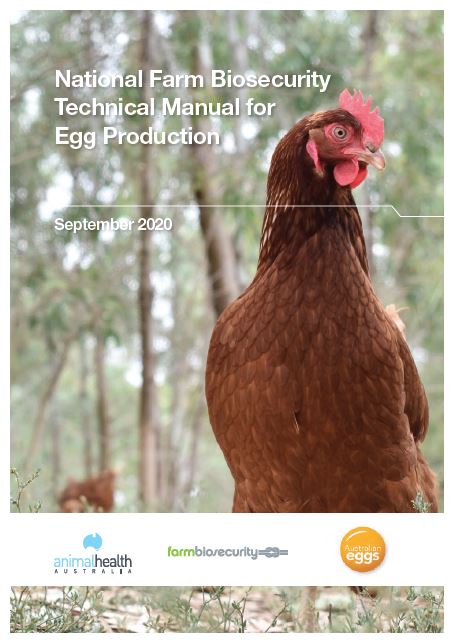Biosecurity and Disease Prevention
Biosecurity
Biosecurity practices and farm hygiene are implemented on poultry farms to reduce the risk of disease agents moving on to farms from outside sources (eg wild bird populations or from other farms), the movement of disease agents between sheds on the same farm, carryover of disease agents from one batch to the next in the shed environment, and carryover of disease agents from breeding flocks to their progeny via the egg. Farmers take a range of precautions to prevent the entry of diseases onto broiler farms.
Australian National Farm Biosecurity Manuals
The purpose of these manuals is to establish a minimum set of biosecurity standards, applicable to all poultry producers (including ratites). While these manuals were produced with commercial producers in mind, the principles of good biosecurity apply to any poultry or bird-raising operation. Individual producers and companies may wish to develop enhanced biosecurity manuals, which should nevertheless incorporate these minimum standards in addition to any specific company or industry sector requirements.
Exhibition Bird Biosecurity
Biosecurity for Backyard Poultry Production
The increasing popularity of backyard poultry production as either a hobby or a means of alleviating poverty in lesser developed countries has recently received increasing interest. Village and backyard poultry production have become an essential aspect of daily survival in countries such as South Africa and the Pacific Islands. For this reason, biosecurity is of utmost importance in protecting flocks from deadly diseases and by safeguarding valuable economic investments and community development.
Depending on the circumstances, if live birds (chicks) are purchased it is essential that birds of different species or age are never mixed, due to the varying immune abilities of different breeds and ages (deGraft Hanson, 2002). What one bird/breed may be immune to may be deadly to another. Housing cleanliness and hygiene is essential in curbing disease spread. Litter must be kept clean and dry at all times, wet or dirty litter can contribute to pathogen development which can result in such diseases as “breast blisters and footpad dermatitis” (deGraft Hanson, 2002).
By following strict routine and biosecurity practices (see above) including maintaining basic record sheets (eggs-laid, mortality, feed-consumed) the backyard/village producer will also be able to observe when a disease agent may have penetrated the flock. As implementing biosecurity is the most cost effective disease prevention means available, by following these three simple rules: “Isolation, Traffic Control & Sanitation” (Jeffrey), the producer should effectively be able to minimise any preventable disease outbreaks. It is also important never to share tools or equipment or accept birds from neighbours (deGraft-Hanson). By effectively separating birds in an enclosure, the likelihood of them coming into contact with pathogen carrying animals or these animals accessing the flock can significantly be reduced. Though wild-birds present a direct threat to biosecurity, it is essential to ensure that household pets do not come into contact with the flock. It is also necessary that the producer remember to disinfect their hands/clothing and shoes after being in direct contact with other livestock and family pets (deGraft-Hansona). Sanitation is highly important to successful disease control. Choosing an effective sanitation product to curb disease development depends on the producer’s individual circumstances (such as cost, transport & degree of operation). Sanitation (disinfectant) products can be broken up into:
- Phenols
- Hypochlorites (chlorine)
- Iodophors (iodine)
- Quaternary ammonium
- Formaldehyde gas
- Formaldehyde powder
- Alkali (lye)
- Chlorhexidine (Nolvasan)
(Jeffrey)
In choosing a sanitation product it is important to consider what type of surface each is best suited for. Phenol is an effective agent in controlling disease growth in organic environments, or in other words “dirty environments”, whereas Hypochlorites and Iodophors are better suited to sanitise processing areas such as benches, walls & foot-baths (Jeffrey). It is recommended that the producer seek professional advice on which sanitiser is best suited for their production needs.
An effective pest control program is important to guarantee the success of backyard and village poultry biosecurity. As rodents, in particular rats & mice, are attracted to poultry feed combined with their ability to enter even the most well fenced off areas, baiting is as important to biosecurity as is good sanitisation (deGraft-Hansona).
Early detection and effectively being able to identify contagious disease outbreaks is very important in implementing harm minimisation action. Though biosecurity measures might appear to be functioning soundly, the imminent risk of disease outbreak does not diminish. IMMEDIATE action to further prevent the disease from spreading MUST be taken (including quarantining visibly affected birds and contacting a Veterinarian or poultry expert) should the flock at any time demonstrate any of the following symptoms:
- Lack of energy and appetite
- Decreased egg production
- Soft-shelled eggs or misshapen eggs
- Swelling of the head, eyes, comb, wattles and hocks
- Purple discolouration of the wattles, combs and legs
- Nasal discharge
- Coughing, wheezing and sneezing
- Lack of coordination in mobility
- Diarrhea
- Sudden or excessive mortality without clinical signs
(Cunningham & Fairchild, 2009)
- Need a disease diagnosis? Cost-effective rapid tests for a range of poultry diseases are now available from the Asia Pacific Centre for Animal Health.
Risk from human movement
As people are considered to be one of the biggest risks insofar as carrying poultry diseases onto chicken farms, particularly on their footwear, clothing, hands and even vehicles, growers take a number of measures to minimise the risks they pose.

These may include:
- Signage and gates at access points to the farm to discourage/prevent unauthorised entry to the farm
- Visitors and service providers to the farm must wear overalls and boots provided by the farmer;
- Provision of foot washing baths at the entrance of each shed for disinfection of footwear prior to shed entry
- Vehicle movements onto the farm are minimised, and vehicles or equipment that may have visited another farm may be required to be washed down before entry
- Where people or vehicles must move between farms on the same day without thorough disinfection between farm visits, movements are scheduled such that the youngest flocks are visited first and the oldest last.
As wild birds can carry some diseases onto the farm, a number of measures are taken to minimise the possibility of wild birds (or their droppings) coming in contact with the chicken flock. These measures include:
- wire netting the sheds so that they are bird proof;
- farmers (and their employees) are not allowed to keep any birds as pets;
- wild birds are discouraged from visiting the farm site, by ensuring that there is no spilled feed left lying around and, where practical, no dams that attract water birds;
- where the water that supplies the shed could be contaminated by wild birds eg dam or river water, it must be sanitised.
Disease prevention
Farmers have a documented pest control program to reduce the risk of diseases being carried on to the farm by rodents. Strict records are kept by the farmer of the chickens’ health, growth and behaviour so that any emerging disease problem is rapidly identified and acted upon.
Disease prevention is an essential strategy for poultry producers. It is much more beneficial to the birds and to the commercial poultry producer to prevent disease from occurring rather than to rely on treatment. The agents which sound biosecurity practices attempt to prevent include “bacteria, viruses, protozoa, fungi, parasites, and any other agents capable of introducing an infectious disease into a poultry flock” (deGraft-Hansona).

Breeding stock (Source: Aust. Chicken Meat Fed.)
General husbandry
Healthy, unstressed birds have an active metabolism and effective immune system to protect them against disease. Feeding birds appropriately with a nutritionally balanced diet, maintaining a comfortable living environment and minimising fear and anxiety in the birds will help the bird’s natural protective mechanisms to function optimally.
Stock selection
Different genetic lines of poultry may vary in their ability to resist or recover from some diseases. The choice of genetic lines resistant to disease problems that have been known to occur in a particular poultry operation can substantially reduce the costs of disease and other disease prevention techniques.
Vaccination
Vaccines aid in preventing disease by stimulating the bird’s immune system in such a way that it enhances the immune response when the bird is subsequently exposed to a pathogen (or disease-causing organism). Classically, vaccines have either contained a small live dose of a weak form of the pathogen or a larger dose of a killed preparation of the disease-causing organism. The weak forms of pathogens used in live vaccines can either be naturally occurring or can be developed in a laboratory. If they have been developed they are called attenuated vaccines. Live vaccines tend to give longer immunity than killed vaccines because the live organism can colonise and survive in the host for some time and stimulate a longer and more effective immune response. New technologies are leading to improved methods of developing vaccines. These include more efficient methods for identifying the ways organisms cause disease and stimulate an immune response in the host, as well as highly specific and effective attenuation procedures.
Biological Risk Management

References
- Dan L. Cunningham & Brian D. Fairchild: “Biosecurity Basics for Poultry Growers,” The University of Georgia Poultry Extension.
- Joan S. Jeffrey: “Biosecurity for Exotic Fowl,” Texas Agricultural Extension Service.
- June deGraft-Hanson a: “Biosecurity for the Poultry Industry,” Extension Service West Virginia University, 2002.
- June deGraft-Hanson: Biosecurity for Backyard Flocks,” Extension Service West Virginia University, 2002.
Further information
- Blackall, P.J. 2005, Discussion Paper- Public health risks from use of waste products, Australian Poultry CRC, Armidale.




